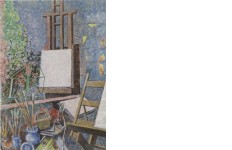Γλυπτική 15Σχέδιο 72Ελαιογραφία 74Τέμπερα 5Μικτή Τεχνική 30Υδατογραφία 15Χαρακτική 6Ακρυλικά 9Gouache 5Αυγοτέμπερα 2
Ειδικές Πληροφορίες για τον Καλλιτέχνη
TITΛΟΣ ΕΡΓΟΥΕΡΓΑΣΤΗΡΙΟ ΜΕ ΚΑΒΑΛΕΤΟ
ΔΙΑΣΤΑΣΕΙΣ ΕΡΓΟΥΎψος : 122
Πλάτος : 86
ΥΛΙΚΟ ΚΑΤΑΣΚΕΥΗΣΑκρυλικά (Ακρυλικό σε καμβά)
ΥΠΟΓΡΑΦΗ ΚΑΛΛΙΤΕΧΝΗΚάτω δεξιά και στην πίσω όψη
ΧΡΟΝΟΛΟΓΗΣΗ01-01-1984
ΕΛΕΓΧΟΣ ΓΝΗΣΙΟΤΗΤΑΣΔεν έχει ελεγχθεί

Provenance:
Zoumboulakis Galleries, Athens.
Private collection, Athens.
Literature:
'Ghika, the Artist's Studios', Benaki Museum 1999 (illustrated in the exhibition catalogue, p. 101).
Exhibited:
Athens, Zoumboulakis Galleries, Ghika Exhibition, March 1985 (illustrated on the cover and within the exhibition catalogue).
Annotating the catalogue of his 1985 one man show in Athens with an insightful text, Ghika noted: The wooden stretchers, the various types of scaffolding, the palettes in various shapes, the large and small, stiff and flexible spatulas, the rulers, the paintbrushes of different thickness, the containers, the little bottles and jars, the multi-coloured rags; all patient and docile, gratefully and motionlessly awaiting to be forever captured in the magic of the painting. 1
The magic of painting is abundantly conveyed in The studio with easel, this rich, luminous and cheerful work that clearly demonstrates Ghikas ability to scrupulously study the objects around him and delve beyond their veneered surface to capture something of their inner, immutable truth. Festive colours and simplified forms in shallow space convey a sense of understated description combined and balanced with a carefully constructed formal organisation, while the cropped shapes of the two impressive 19th century easels - one of which the great James Whistler had once worked at2 - and the red table with jars of brushes in the extreme foreground create a feeling of open-endedness.
This centrifugal reading is further supported by the intentionally pronounced gridded-off underdrawing of the canvas. By virtue of the grid, which theoretically extends in all directions to infinity, the work of art is presented as a mere fragment, a piece cropped from a larger fabric. Thus the grid operates from the work of art outward, compelling our acknowledgment of a world beyond the frame. In its use as a technical device to help map the space of the room, it recalls the exquisite studies by Ucello, Leonardo or Dürer, where the perspective lattice was described on the depicted world as the armature of its organization. Used, though, as an organic pictorial element it states the autonomy of the realm of art, echoing Piet Mondrians calculated geometric abstractions. Simple, pure and ordered, the grid is an emblematic structure of modernist art, a primary form that creates a sense of absolute beginning, a universal tabula rasa which symbolically expresses the modernist quest for complete origination. 3
This, albeit peaceful and enchantingly beautiful picture, is an intricate lacework of sophistication, reflecting Ghikas fascination with still lifes capacity for inciting expressive and stylistic explorations. According to I. Providi, curator of the Ghika Gallery, such works portray Ghikas close connection to his atelier, the sanctuary of every artist, the vital and sometimes even exclusive place of work. It is where, surrounded by his means of expression, the tools of the trade, his paints and brushes, the artist transformed inspiration into works of art. There is undoubtedly some sort of interdependence between artist and studio: the painter often depicts his workplace, either partially or as a whole. On the other hand, the studios space gradually and almost indiscernibly takes on something of its owners personality and becomes a singular, in situ, work of art; 4 what Providi perceptively calls a psychogram of an interior, where human presence is secretly denoted even with its absence. 5
Successfully combining internal order and analytical approach with expressive colour and energetic line on an animated pictorial surface, The studio with easel eloquently exemplifies the charismatic coexistence of Apollonian and Dionysian elements6 in Ghikas work. His ingenious depiction of golden sunlight flickers on the studio wall behind the easels captured in both austere geometric and playful biomorphic forms suffices to best explain why Ghika is a truly great artist.
1. Ghika exhibition, Zoumboulakis Galleries, Athens 1985.
2. Two heavy, 19th century easels, the products of craftsmen who made for posterity, stood on the floor. James Whistler, the American painter and engraver - who, like Henry James, made his home in England, had once worked at one of these easels. From a short description of Ghikas London studio by John Leatham, as cited in Ghika, the Artists Studios, exhibition catalogue, Benaki Museum, Athens 1999, p. 92.
3. See R. Krauss, The Originality of the Avant-Garde and Other Modernist Myths, MIT Press, London 1986, pp. 9-22, and J. Elderfield, 'Grids', Artforum journal, May 1972, pp. 52-59.
4. I. Kritseli-Providi, 'Ghikas Studios' in Ghika, the Artists Studios, exhibition catalogue, Benaki Museum, Athens 1999, p. 9.
5. Ghika, Landscapes and Interiors, exh. cat., Municipal Gallery of Athens, 2006, p. 9.
6. For a comprehensive discussion on the subject see D. Iliopoulou-Rogan, N. Hadjikyriakos-Ghika, the Apollonian-the Dionysian, exh. cat., Benaki Museum, Athens 2006.